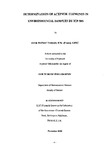Determination of actinide elements in environmental samples by ICP-MS
| dc.contributor.supervisor | Evans, Hywel | |
| dc.contributor.author | Truscott, Jason Bedford | |
| dc.contributor.other | Faculty of Science and Engineering | en_US |
| dc.date.accessioned | 2011-06-28T14:11:41Z | |
| dc.date.available | 2011-06-28T14:11:41Z | |
| dc.date.issued | 2000 | |
| dc.identifier | Not available | en_US |
| dc.identifier.uri | http://hdl.handle.net/10026.1/490 | |
| dc.description.abstract |
Methods for the determination of the actinide elements in water, biological, soil and sediment samples have been developed using on-line solid phase extraction and high performance liquid chromatography (HPLC) coupled with inductively coupled plasma mass spectrometry (ICP-MS). Initial applications utilised a commercially available resin, namely TRU-Spec resin, for efficient removal of the matrix prior to elution of uranium and thorium analytes. Comparative analyses of reference materials and natural water samples from Plymouth and Dartmoor demonstrated significant improvement in precision and speed of analysis by using TRU-Spec coupled to ICP-MS compared with alpha spectrometry. Further applications of the TRU-Spec resin for the determination of the transuranic actinide elements neptunium, plutonium and americium, resulted in the successful determination of 239Pu and 237Np in biological reference materials. Detection limits were 700, 850, and 600 attograms (ag) for 237Np, 233Pu, and 241Am, respectively, for a 0.5 ml sample injection, and better than 200 ag/g with 50 ml pre-concentration when sector field (SF) ICP-MS was used. A method for the selective sequential elution of uranium and plutonium was also developed to facilitate the determination of 239Pu without interference due to the 238U1H+ polyatomic ion, caused by high concentrations of 238U in sediment samples. Investigations were performed into the use of a polymeric substrate, which was dynamically coated with chelating dyes such as xylenol orange and 4-(2-pyridylazo) resorcinol, and a silica substrate coated with permanently bonded iminodiacetic acid. The latter was used for the successful determination of uranium and thorium in certified reference material waters. However, the column was found to have a high affinity for iron, making it unsuitable for the determination of the actinides in soil and sediment samples. Subsequently, a polystyrene substrate which was dynamically coated with dipicolinic acid was used for HPLC coupled with SF-ICP-MS. Using this column it was possible to separate the various actinides from each other and from the matrix. In particular, it was possible to separate plutonium and uranium to facilitate interference-free determination of the former. The column also exhibited some selectivity for different oxidation states of Np, Pu and U. Two oxidation states each for plutonium and neptunium were found, tentatively identified as Np(V) and Pu(III) eluting at the solvent front, and Np(IV) and Pu(IV) eluting much later. Detection limits were 12, 8, and 4 fg for 237Np, 239Pu, and 241Am, respectively, for a 0.5 ml injection, and the system was successfully used for the determination of 239Pu in water, biological and soil reference materials. | |
| dc.language.iso | en | en_US |
| dc.publisher | University of Plymouth | en_US |
| dc.subject | Environmental materials | |
| dc.subject | Environmental measurements laboratory | |
| dc.subject | Mass spectroscopy | |
| dc.subject | ICP-MS | |
| dc.subject | Actinides | |
| dc.subject | Soils | |
| dc.subject | Water | |
| dc.subject | Seawater | |
| dc.subject | Radioactivity | |
| dc.subject | Radiation monitoring | |
| dc.subject | Plutonium 239 | |
| dc.subject | Neptunium 237 | |
| dc.subject | Americium 241 | |
| dc.subject | Plutonium 233 | |
| dc.subject | Radioactive waste | |
| dc.subject | Chemistry | |
| dc.title | Determination of actinide elements in environmental samples by ICP-MS | en_US |
| dc.type | Thesis | |
| dc.identifier.doi | http://dx.doi.org/10.24382/3286 |
Files in this item
This item appears in the following Collection(s)
-
01 Research Theses Main Collection
Research Theses Main


